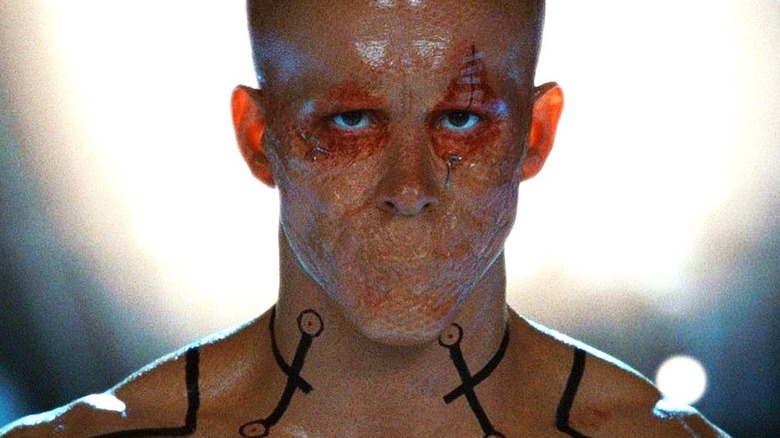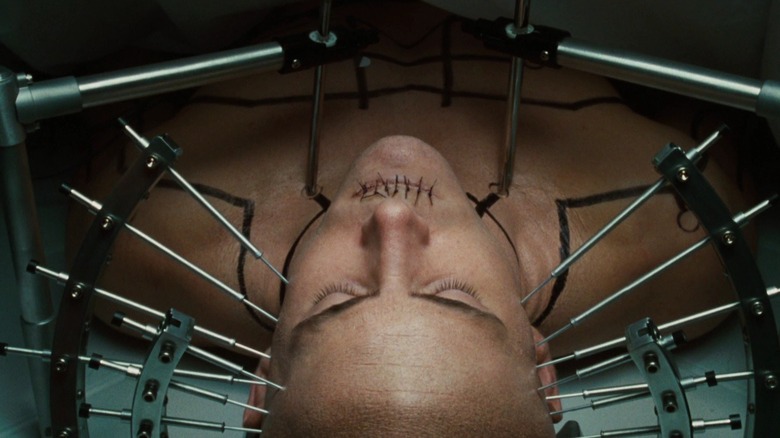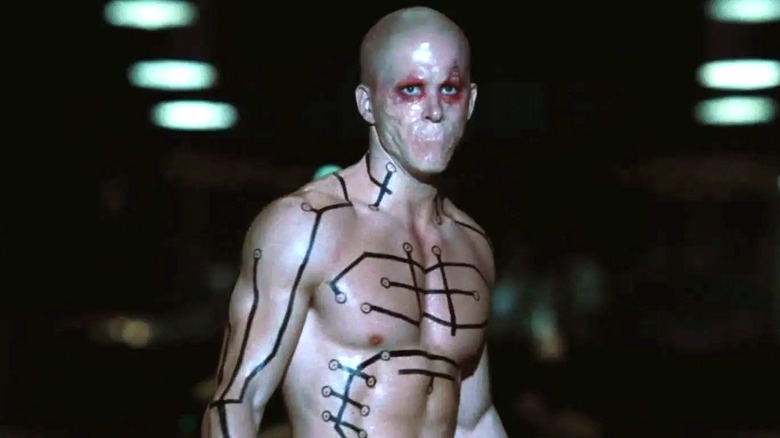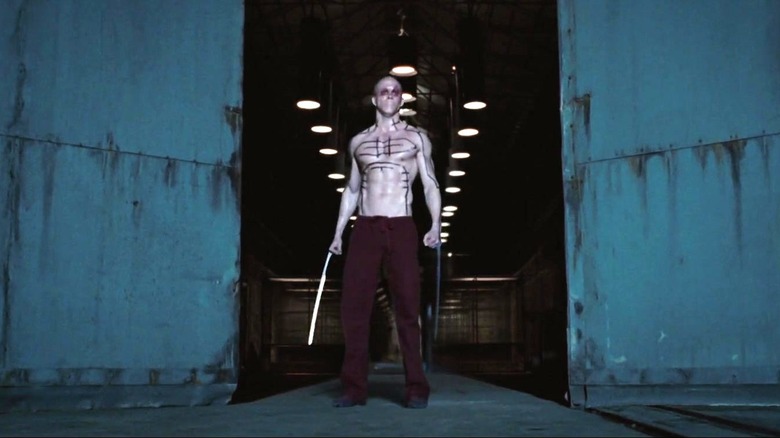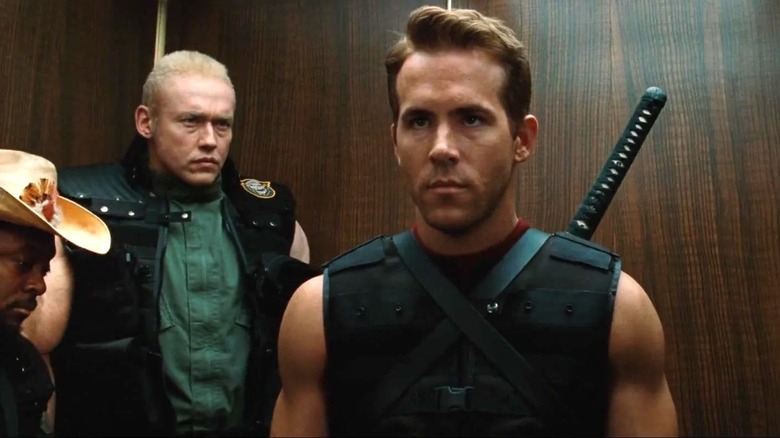Why Is Deadpool In X-Men Origins: Wolverine Different From The MCU Version?
Kick-butt moves, dirty jokes, and plenty of scene-stealing moments that break the fourth wall. These are all hallmarks of the "Deadpool" movies that have been captivating audiences since the first installment was released in 2016. According to an August 2024 report from The Hollywood Reporter that went into detail about Tinseltown's top-grossing R-rated films, "Deadpool" and "Deadpool 2" took fourth and fifth place, respectively. "Deadpool & Wolverine" took the top spot on the list with over $1 billion in global ticket sales. However, Deadpool's movie timeline goes beyond those three successful films.
Before the Merc with a Mouth became Marvel Jesus and joined the Marvel Cinematic Universe, he and Ryan Reynolds were part of a big screen flub. We're talking about 2009's "X-Men Origins: Wolverine," which is without a doubt one of the worst "X-Men" films ever made. Toward the end of the film, Logan (Hugh Jackman) faces off against a very different version of Reynolds' Deadpool that has extra powers, no red suit, and no catchy one-liners, since his mouth is sewn shut. Reynolds revisited the moment during the post-credits scene of "Deadpool 2" by killing off this awkward version of his character. So why did a speechless Deadpool ever make it to the big screen in the first place? There's a few reasons.
Sewing Deadpool's mouth shut was a studio note
While Wade Wilson steals some scenes with witty one-liners at the beginning of "X-Men Origins: Wolverine," his first appearance as Deadpool shares no trademark humor as his mouth is sewn shut. The moment is foreshadowed when Stryker (Danny Huston) tells Wade that he would be the ideal soldier if he couldn't speak. However, it's still a questionable move that left audience members scratching their heads. Ryan Reynolds was equally confused by the decision. He told Variety, "Deadpool sewing up his mouth was one of the all-time foolish studio notes." He has also made fun of the decision on his Facebook page. In the caption for the video announcing Wolverine and Deadpool's big screen reunion, Reynolds wrote, "Hard keeping my mouth sewn shut about this one."
Producer Jeff Katz spoke about the decision with "The Geek Generation" Podcast. He said that Fox chose this direction based on how they thought the fight scene should play out. "It literally came down to them going like, 'We don't want a guy talking in the middle of a fight — that's cheesy,'" Katz explained. "And it almost became a thing about obstinance to be like, 'We're gonna show you we're right, the comic fans are wrong, and it doesn't matter.'" Katz tried to tell the head of the studio that this would lead to a fallout, but he said that they had a strategy to acknowledge Deadpool's trademark mouth by giving Wolverine a funny one-liner mentioning the well-known nickname.
Why Deadpool's skin is different in X-Men Origins: Wolverine
Deadpool's skin is just as iconic as his shiny red suit. However, in "X-Men Origins: Wolverine," the scars are traded in for smooth skin with black lines ending in circles across the upper half of his body. This could be because the process used to transform Wade Wilson is much different from what is seen in 2016's "Deadpool."
Like Logan, Wade undergoes an infusion of the metal alloy adamantium in the 2009 film. Black lines with circles are spotted on Logan as he emerges from the water amid his transformation, and they are very similar to the markings seen on Wade later in the film. These markings are not seen on Logan beforehand, meaning that Stryker and his team drew the markings on him and Wade in order to help conduct the experimentation and transformation process. The truth about Wolverine's adamantium skeleton is that it weighs 105 pounds, so it's important that everything is planned out when inserting that much hardware.
This is a much more methodical process compared to Wade's transformation in "Deadpool," which mainly focuses on Wade being left inside a chamber that is draining the oxygen from his body during an experiment that ultimately activates his mutation. As the oxygen extraction begins, the audience can see his skin start to scar.
Wade Wilson has extra powers in X-Men Origins: Wolverine because he's a combination of characters
Stryker wants the best soldier possible, and that's why Deadpool has extra powers in "X-Men Origins: Wolverine." He can shoot lasers out of his eyes, teleport, and even pull katana blades out of his knuckles. Each power has its own familiarity because each idea came from the abilities of mutants that Stryker has come into contact with. Former Team X member John Wraith (Will.i.am) could teleport, Scott Summers' (Tim Pocock) laser eyes are implanted into Deadpool, and the katana blade knuckles are a callback to Wade's own swashbuckling skills. Of course, Stryker has been planning this all out for quite some time.
While he has faith in Team X at the beginning of the film, Stryker shows favor toward Wade. He verbally acknowledges his fighting skills while asking Wade to be the first to enter a room filled with armed people operating a diamond smuggling facility in Lagos, Nigeria. Wade seems to be used to entering a room first, whipping his blades around with ease before giving the all clear to his teammates. So, it's clear that he is Stryker's favorite, and their leader may already be realizing that Team X will not be together forever, meaning he has to come up with a backup plan.
That plan is evident in Deadpool's reveal and his many abilities. He really is the ultimate version of Team X, and he is totally under Stryker's control thanks to remote control capabilities. Unlike the original Team X, Deadpool has no free will, meaning that Stryker never has to hear anyone reject his evil schemes ever again.
Fox didn't want Deadpool to wear his iconic red and black costume in X-Men Origins: Wolverine
"X-Men Origins: Wolverine" happened way before the "Deadpool" movies that people know and love today. That means that there was another plan being built around the character during the mid-2000s. That's according to Alex Gillis, the co-founder of special effects company Amalgamated Dynamic Inc. Gillis was in charge of Deadpool's makeup and design. He told Vulture that they had to consider how this story was veering off from the source material, and when it came to forgoing the iconic red and black suit, that was Fox's choice. The studio said it was too early to debut it. "We were told at the time that this was an introduction to the Deadpool character, and that he would be getting his own movie after this one," Gillis said. "We were also told that Ryan's stunt double, Scott Adkins, would be filming that fight scene at the end, and you wouldn't even need Ryan on set."
It's a bold move to try something different with a character that has such a loyal fanbase. "X-Men Origins: Wolverine" director Gavin Hood has since looked back on that film's version of Deadpool, and he told Cinemablend that the newer movies starring the Merc with a Mouth are much better. "I think the character works so well now, because the character is allowed to be who the character really is, unencumbered by, you know, PG-13 requirements and a great deal of marketing debate," he said. Going by critical reception and box office receipts, he's not wrong. Reynolds turned Deadpool from a favorite among comic book aficionados to a pop culture phenomenon simply by being true to the source material.
